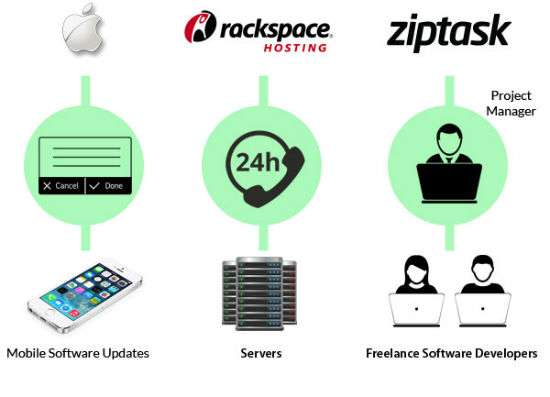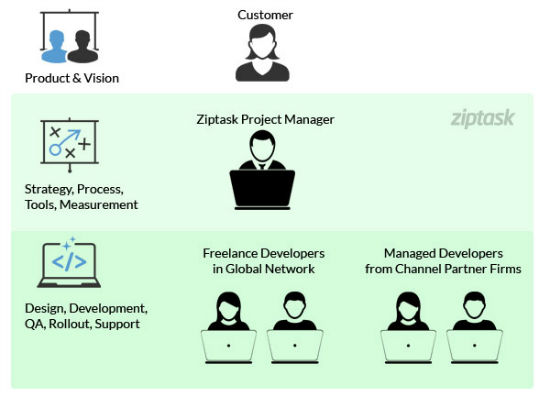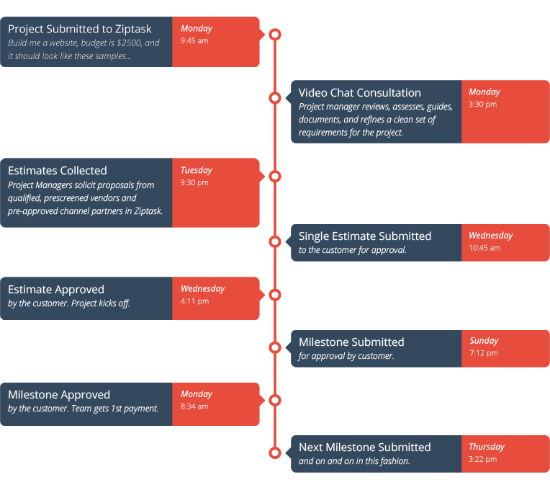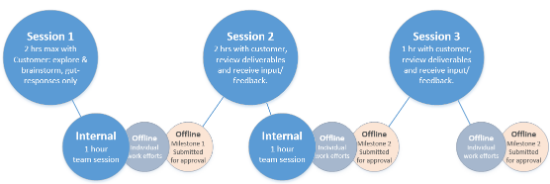Work 3.0: Will Ziptask Disrupt the Outsourcing Market?
The international outsourcing market is giant-sized, hundreds of billions of dollars strong. A numerous amount of web platforms aims to monetize that market. 99designs is one example, oDesk and Elance are others. You have probably tried to find work through one of these platforms yourself and I bet the experience was not exactly a walk in the park. Now look through the lense of a company that wants to hire four or five qualified freelance developers this way. Their problems are even bigger. Ziptask promises to care for both sides of the table. With their man-in-the-middle approach, getting project work and getting projects done grows much more likely and far more effective than any other method I know.


 According to Shawn, this middle layer is the key to the solution of outsourcing projects while still getting a good night's sleep. And undoubtedly, this middle layer is something the competition simply doesn't deliver. Which is understandable as it is much easier for the platform as such to go for the simplest possible solution to earn money. And this is bringing customer and freelancer together and let them fight their fight on their own. Of course, you can easily guess, this is neither the best solution for the customer nor for the qualified freelancer. The qualified freelancer faces fierce competition by people who know just enough about computers to fill in an application form without too many errors. And the customer will most likely choose these lesser qualified people as they promise lower wages. Noone wins in these cases.
Outsourcing is not just about bringing purchaser and contractor together, then leave them alone. There is much more to it. And that is, the problems of building quality software with people that you’ve never before heard of and will likely never see in real life. Cultural and linguistic diversity has already been mentioned, so have timezones. How do you hold these people accountable for their work and establish standards of quality that are adhered to? All these problems are not properly touched upon by competing platforms.
According to Shawn, this middle layer is the key to the solution of outsourcing projects while still getting a good night's sleep. And undoubtedly, this middle layer is something the competition simply doesn't deliver. Which is understandable as it is much easier for the platform as such to go for the simplest possible solution to earn money. And this is bringing customer and freelancer together and let them fight their fight on their own. Of course, you can easily guess, this is neither the best solution for the customer nor for the qualified freelancer. The qualified freelancer faces fierce competition by people who know just enough about computers to fill in an application form without too many errors. And the customer will most likely choose these lesser qualified people as they promise lower wages. Noone wins in these cases.
Outsourcing is not just about bringing purchaser and contractor together, then leave them alone. There is much more to it. And that is, the problems of building quality software with people that you’ve never before heard of and will likely never see in real life. Cultural and linguistic diversity has already been mentioned, so have timezones. How do you hold these people accountable for their work and establish standards of quality that are adhered to? All these problems are not properly touched upon by competing platforms.

 You can learn more about product studio at their micro-site for that offer.
The end result of product studio is a customer walking away with mockups and cleanly written requirements documentation, along with a clarified vision of what the project should be, how it will be accomplished, what technology stack should it be built upon, and what features should exist.
You can learn more about product studio at their micro-site for that offer.
The end result of product studio is a customer walking away with mockups and cleanly written requirements documentation, along with a clarified vision of what the project should be, how it will be accomplished, what technology stack should it be built upon, and what features should exist.

Ziptask, a Different Breed of Outsourcing Platform
Ziptask created something different. Instead of bringing together freelancers and customers directly, one to one, or more likely one to (far too) many, they built a “fully managed” version of outsourcing. Instead of hiring the freelancer directly, a customer gets to hire a seasoned project manager. This project manager then goes out and puts together a team, or just finds the right person. In this step, the project manager gets the project packaged and starts to sift through his network of prescreened vendors and freelancers. He then negotiates the prices, and finally selects the right team or individual developer. As the network consists of skilled freelancers only, there is no need to further separate the wheat from the chaff. The customer stays in the driver's seat as the project manager only takes in estimates from as many freelancers as might possibly qualify for the job. After having taken in numerous estimates, the project manager narrows down the choice, preselects the freelancer or team he sees as the best fit for the project and sends this out to the customer as a final estimate. The customer is then entitled to either approve or reject it. If approved, the project manager kicks off the project and gets the team in motion. They work on the project and deliver results back, one milestone at a time. The project manager checks and re-checks the work, insulating the customer from all the potential pains that are likely to occur during any outsourcing process. Once a milestone is reached and approved, the customer pays for the work done up to this milestone. Done that way, outsourcing becomes seamless to the customer. Ziptask does it the way companies such as Apple or Rackspace do. They make it look so easy. Just click on a button and something spins, downloads, installs, etc. Just call the toll-free phone number and tell the server guy that the server isn’t right. Then he fixes it for you. It’s tantamount to fixing the problem: hiding it. If the customer doesn’t feel the pain, was there any pain at all? Arguably, no.
Outsourcing Software Projects: Typically a Pain in ...
Have you ever tried to outsource a project? I did once. I had a team of freelancers from India (nothing against India, though) build me a software solution for a complaint management, basically a ticketing system but with some twists. These twists hindered me from just customizing one of the many ticketing systems out there. My project was clearly defined, a documentation of more than 100 pages had been written in English, while the project was meant to be for the German market, even mockups had been scribbled. I was sure to be best prepared. I took time to select the right team. I got into pain anyway. This project soon became one of the worst experiences of my professional life. Timezones and communication needs can really wear you out. Cultural differences and different interpretations of quality come into play, even different interpretations of the word "timely" can break your schedule. After that experience I can fully relate to what Shawn Livermore, CEO of Ziptask told me in an interview we had a few days ago:It’s just reality. Nobody wants to admit it. Nobody wants to go there, but outsourcing to non-native English speaking resources can be really painful. Try it. You will see what I mean. It’s anything but sexy. You will earn your paycheck. And whatever money you think you saved, it’s gobbled up by your time sitting there explaining things 10 times and starting over again once you’ve burned through the first 3 developers who disappeared or were fired. Messy… no, slimy-mc-nasty outsourcing needs a facelift. The inmates are running the asylum. Freelancers gone wild. It’s madness I tell you. Who will stop the pain?Shawn's answer to this last question is the introduction of the project manager concept. He’s basically the go-between, the consultant, the man in the middle, the overseer. Shawn Livermore describes him like this:
The developers are (sometimes) an unknown quantity, (depending)… and the customer typically knows enough to be dangerous, but not necessarily exactly how to make it all come together. The project manager introduces process and theory. He brings order to the chaos. It’s why they call it, “Computer Science”, because there is in fact a technical science to the process of creating software. The project manager knows those processes, has implemented numerous projects in the past, and uses cool words like, “efficacious”, “criterion”, “methodological”, and of course our favorite, “deliverable”. The project manager is trained on spotting Bull $#@! from these fake freelancer wanna-be’s, who slipped through the prescreening process somehow. He is empowered to hire and fire people. He can intervene as needed, and quickly reframe the project as something manageable, versus an ongoing never ending pile of drama. He can materialize requirements that sound really good out of thin air. These guys typically cost a lot of money, and are hard to find. They used to be programmers, or the seller programmers, but they’re better at managing people and overseeing projects than they are at remembering the syntax for parsing a string variable array. It’s only natural that these guys would be the ones that Ziptask leans on to facilitate and oversee their projects.
 According to Shawn, this middle layer is the key to the solution of outsourcing projects while still getting a good night's sleep. And undoubtedly, this middle layer is something the competition simply doesn't deliver. Which is understandable as it is much easier for the platform as such to go for the simplest possible solution to earn money. And this is bringing customer and freelancer together and let them fight their fight on their own. Of course, you can easily guess, this is neither the best solution for the customer nor for the qualified freelancer. The qualified freelancer faces fierce competition by people who know just enough about computers to fill in an application form without too many errors. And the customer will most likely choose these lesser qualified people as they promise lower wages. Noone wins in these cases.
Outsourcing is not just about bringing purchaser and contractor together, then leave them alone. There is much more to it. And that is, the problems of building quality software with people that you’ve never before heard of and will likely never see in real life. Cultural and linguistic diversity has already been mentioned, so have timezones. How do you hold these people accountable for their work and establish standards of quality that are adhered to? All these problems are not properly touched upon by competing platforms.
According to Shawn, this middle layer is the key to the solution of outsourcing projects while still getting a good night's sleep. And undoubtedly, this middle layer is something the competition simply doesn't deliver. Which is understandable as it is much easier for the platform as such to go for the simplest possible solution to earn money. And this is bringing customer and freelancer together and let them fight their fight on their own. Of course, you can easily guess, this is neither the best solution for the customer nor for the qualified freelancer. The qualified freelancer faces fierce competition by people who know just enough about computers to fill in an application form without too many errors. And the customer will most likely choose these lesser qualified people as they promise lower wages. Noone wins in these cases.
Outsourcing is not just about bringing purchaser and contractor together, then leave them alone. There is much more to it. And that is, the problems of building quality software with people that you’ve never before heard of and will likely never see in real life. Cultural and linguistic diversity has already been mentioned, so have timezones. How do you hold these people accountable for their work and establish standards of quality that are adhered to? All these problems are not properly touched upon by competing platforms.
Ziptask: Not Just an Algorithmic Piece of Code, but a Human Platform
Wait, there is a downside to Ziptask's approach. The additional project manager doesn't work for free, thus adds to the cost. Shawn Livermore has analyzed past projects and argues:Yes, there is an additional person involved, which some might argue as a layer of investment on top of existing investment. But the net result is clearly positive. Customers will save 1 to 2 weeks on project initiations, and 3 to 4 weeks on development efforts, using the right tools, resources, and platform technologies from the very beginning.The human factor is important to Ziptask. Shawn says:
Ziptask's focus is not on an algorithm or a piece of plug-in code, but on the poignant engagement of a skilled project manager. You talk face to face on video chat to your designated project manager right away, who you selected yourself from a list. That project manager offers you insight and clarity on the work that you’re trying to get done before you even commit anything and before you have to whip out a credit card. The project manager basically takes it all in and in a seemingly magical way, makes sense of it. This is not to be underestimated. Case and point: the guy who fixed my gas dryer hookup only needed a fraction of the time that it took me on the first three tries to install the gas dryer. He tapped a few things tightened a few things and then knew exactly what the problem was. Plumbers do the same thing. They might charge you 100 bucks for that five minutes of tapping on a pipe and feeling the wall, but somehow they get it fixed, almost effortlessly. Ziptask project managers know how to tap on the right pipes, getting right to the heart of the website, mobile app, or even more sophisticated software effort that customers are shooting for. It’s knowing which questions to ask. It’s feeling through the essence of the brand, and envisioning something more focused on the heart of the target market. (Good luck saying the phrase “target market” to a remote freelancer you hired on oDesk for $5.66 per hour.)Below is a typical timeline for a project.

Ziptask's Product Studio: Building a Project
Outsourcing a project has a few preconditions. First and foremost, a project needs to exist. In real life problems are bound to arise at this point already. Ziptask customers come knocking at the front door with an idea but no written requirements, and no designed mockups. They did have an idea of what they were looking to build, but nothing tangible for the developers to work with, and no wireframes to speak up. In fact, when project managers ask about wireframes, the customer common retort is, “What’s a wireframe?”. Ziptask made that problem their own. While customers don't have any project to outsource, Ziptask would not be able to earn money by managing that project. So why not help the customer get his project on track in the first place? The guys over at Ziptask filtered two main problems to solve. The problem of documentation and the problem of materializing visuals that capture the essence of what the project is in the mind of the customer. They created a whole new product line called “Product Studio”. "Product Studio" is an add-on to Ziptask classic “Fully Managed” flow, and essentially their fixed-price option. It allows project managers to pull in a designer, and a business analyst, and meet with the customer on 3 video chat sessions, deliberating on all of the project details, creating tangible assets. Some of those assets are:- Requirements document
- Photoshop mockups
- Wireframes
- Flowcharts
- Project overview/plan document
 You can learn more about product studio at their micro-site for that offer.
The end result of product studio is a customer walking away with mockups and cleanly written requirements documentation, along with a clarified vision of what the project should be, how it will be accomplished, what technology stack should it be built upon, and what features should exist.
You can learn more about product studio at their micro-site for that offer.
The end result of product studio is a customer walking away with mockups and cleanly written requirements documentation, along with a clarified vision of what the project should be, how it will be accomplished, what technology stack should it be built upon, and what features should exist.
